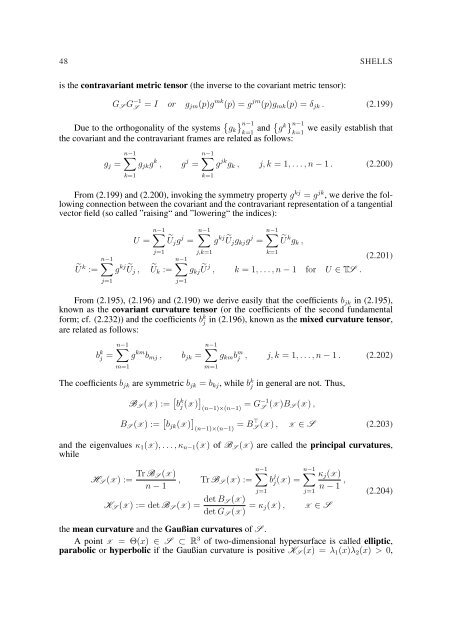EQUATIONS OF ELASTIC HYPERSURFACES
EQUATIONS OF ELASTIC HYPERSURFACES
EQUATIONS OF ELASTIC HYPERSURFACES
Create successful ePaper yourself
Turn your PDF publications into a flip-book with our unique Google optimized e-Paper software.
48 SHELLS<br />
is the contravariant metric tensor (the inverse to the covariant metric tensor):<br />
G S G −1<br />
S = I or g jm(p)g mk (p) = g jm (p)g mk (p) = δ jk . (2.199)<br />
Due to the orthogonality of the systems { } n−1<br />
g k and { g k} n−1<br />
we easily establish that<br />
k=1 k=1<br />
the covariant and the contravariant frames are related as follows:<br />
∑n−1<br />
∑n−1<br />
g j = g jk g k , g j = g jk g k , j, k = 1, . . . , n − 1 . (2.200)<br />
k=1<br />
k=1<br />
From (2.199) and (2.200), invoking the symmetry property g kj = g jk , we derive the following<br />
connection between the covariant and the contravariant representation of a tangential<br />
vector field (so called ”raising“ and ”lowering“ the indices):<br />
∑n−1<br />
U = Ũ j g j =<br />
j=1<br />
∑n−1<br />
j,k=1<br />
∑n−1<br />
g kj Ũ j g kj g j = Ũ k g k ,<br />
∑n−1<br />
∑n−1<br />
Ũ k := g kj Ũ j , Ũ k := g kj Ũ j , k = 1, . . . , n − 1 for U ∈ TS .<br />
j=1<br />
j=1<br />
k=1<br />
(2.201)<br />
From (2.195), (2.196) and (2.190) we derive easily that the coefficients b jk in (2.195),<br />
known as the covariant curvature tensor (or the coefficients of the second fundamental<br />
form; cf. (2.232)) and the coefficients b k j in (2.196), known as the mixed curvature tensor,<br />
are related as follows:<br />
b k j =<br />
∑n−1<br />
m=1<br />
g km b mj , b jk =<br />
∑n−1<br />
m=1<br />
g km b m j , j, k = 1, . . . , n − 1 . (2.202)<br />
The coefficients b jk are symmetric b jk = b kj , while b k j in general are not. Thus,<br />
B S (X ) := [ b k j (X ) ] (n−1)×(n−1) = G−1 S (X )B S (X ) ,<br />
B S (X ) := [ b jk (X ) ] (n−1)×(n−1) = B⊤ S (X ) , X ∈ S (2.203)<br />
and the eigenvalues κ 1 (X ), . . . , κ n−1 (X ) of B S (X ) are called the principal curvatures,<br />
while<br />
H S (X ) := Tr B S (X )<br />
n − 1<br />
∑n−1<br />
, Tr B S (X ) :=<br />
j=1<br />
K S (X ) := det B S (X ) = det B S (X )<br />
det G S (X ) = κ j(X ) ,<br />
n−1<br />
b j j (X ) = ∑<br />
j=1<br />
κ j (X )<br />
n − 1 ,<br />
X ∈ S<br />
(2.204)<br />
the mean curvature and the Gaußian curvatures of S .<br />
A point X = Θ(x) ∈ S ⊂ R 3 of two-dimensional hypersurface is called elliptic,<br />
parabolic or hyperbolic if the Gaußian curvature is positive K S (x) = λ 1 (x)λ 2 (x) > 0,

















